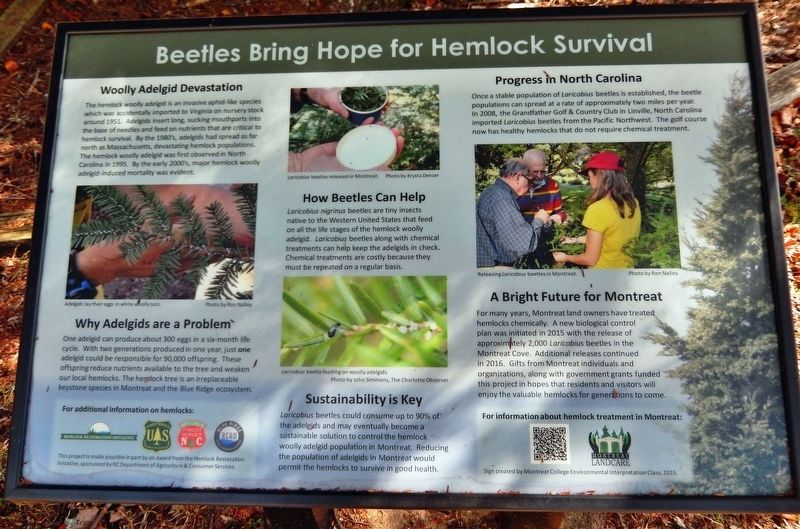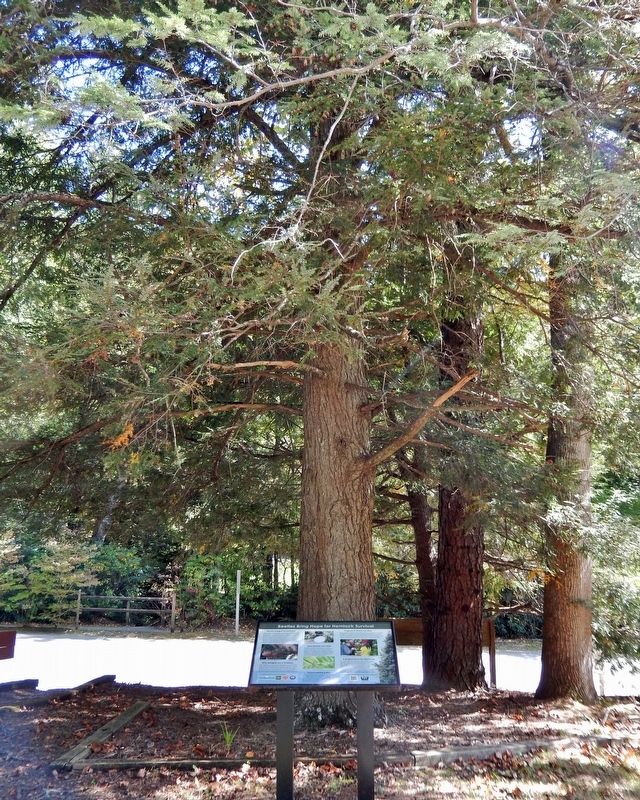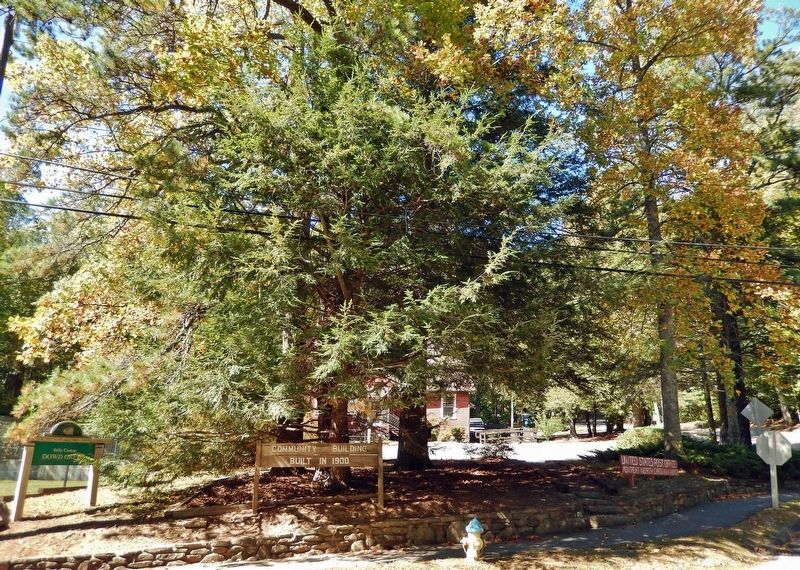Montreat in Buncombe County, North Carolina — The American South (South Atlantic)
Beetles Bring Hope for Hemlock Survival
Woolly Adelgid Devastation
The hemlock woolly adelgid is an invasive aphid-like species which was accidentally imported to Virginia on nursery stock around 1951. Adelgids insert long sucking mouthparts into the base of needles and feed on nutrients that are critical to hemlock survival. By the 1980's, adelgids had spread as far north as Massachusetts, devastating hemlock populations. The hemlock woolly adelgid was first observed in North Carolina in 1995. By the early 2000's, major hemlock woolly adelgid-induced mortality was evident.
Why Adelgids are a Problem
One adelgid can produce about 300 eggs in a six-month life cycle. With two generations produced in one year, just one adelgid could be responsible for 90,000 offspring. These offspring reduce nutrients available to the tree and weaken our local hemlocks. The hemlock tree is an irreplaceable keystone species in Montreat and the Blue Ridge ecosystem.
How Beetles Can Help
Laricobius nigrinus beetles are tiny insects native to the Western United States that feed on all the life stages of the hemlock woolly adelgid. Laricobius beetles along with chemical treatments can help keep the adelgids in check. Chemical treatments are costly because they must be repeated on a regular basis.
Sustainability is Key
Laricobius beetles could consume up to 90% of the adelgids and may eventually become a sustainable solution to control the hemlock woolly adelgid population in Montreat. Reducing the population of adelgids in Montreat would permit the hemlocks to survive in good health.
Progress in North Carolina
Once a stable population of Laricobius beetles is established, the beetle populations can spread at a rate of approximately two miles per year. In 2008, the Grandfather Golf & Country Club in Linville, North Carolina imported Laricobius beetles from the Pacific Northwest. The golf course now has healthy hemlocks that do not require chemical treatment.
A Bright Future for Montreat
For many years, Montreat land owners have treated hemlocks chemically. A new biological control plan was initiated in 2015 with the release of approximately 2,000 Laricobius beetles in the Montreat Cove. Additional releases continued in 2016. Gifts from Montreat individuals and organizations, along with government grants funded this project in hopes that residents and visitors will enjoy the valuable hemlocks for generations to come.
[photo captions]
• Adelgids lay their eggs in white woolly sacs. Photo by Ron Nalley
• Laricobius beetles released in Montreat. Photo by Krysta Denzer
•
Laricobius beetle feeding on woolly adelgids. Photo by John Simmons, The Charlotte Observer
• Releasing Laricobius beetles in Montreat. Photo by Ron Nalley
Erected 2015 by Montreat College Environmental Interpretation Class; Hemlock Restoration Initiative; and North Carolina Department of Agriculture & Consumer Services.
Topics and series. This historical marker is listed in these topic lists: Animals • Education • Horticulture & Forestry • Science & Medicine. In addition, it is included in the Blue Ridge Parkway series list. A significant historical year for this entry is 1951.
Location. 35° 38.693′ N, 82° 18.138′ W. Marker is in Montreat, North Carolina, in Buncombe County. Marker can be reached from the intersection of Assembly Drive and Georgia Terrace, on the left when traveling north. The marker is located in front of a giant Hemlock tree on the east side of the United States Post Office parking lot. Touch for map. Marker is at or near this postal address: 301 Assembly Drive, Montreat NC 28757, United States of America. Touch for directions.
Other nearby markers. At least 8 other markers are within 3 miles of this marker, measured as the crow flies. Montreat's Rich Heritage is a Place of Renewal (approx. 0.2 miles away); Boone Trail Highway (approx. 0.2 miles away); Lake Susan (approx. ¼ mile away); Mount Mitchell Railroad
(approx. 1.8 miles away); Montreat College (approx. 2.1 miles away); Stoneman's Raid (approx. 2.2 miles away); Grey Eagle (approx. 2.2 miles away); Black Mountain (approx. 2.2 miles away). Touch for a list and map of all markers in Montreat.
Also see . . .
1. Hemlock woolly adelgid (Wikipedia). Excerpt:
Adelges tsugae, or HWA, is an insect native to East Asia. It feeds by sucking sap from hemlock and spruce trees. In its native range, HWA is not a serious pest because populations are managed by natural predators and parasitoids and by host resistance. In eastern North America it is a destructive pest that threatens the eastern hemlock (Tsuga canadensis) and the Carolina hemlock (Tsuga caroliniana). HWA is also found in western North America, where it has likely been present for thousands of years. In western North America, it primarily attacks western hemlock (Tsuga heterophylla) and has only caused minor damage due to natural predators and host resistance. Accidentally introduced to North America from Japan, HWA was first found in the eastern United States near Richmond, Virginia, in 1951. The pest is now found from northern Georgia to coastal Maine and southwestern Nova Scotia.(Submitted on December 16, 2023, by Cosmos Mariner of Cape Canaveral, Florida.)
2. Laricobius nigrinus (Wikipedia). Excerpt:
Laricobius nigrinus is a species of tooth-necked fungus beetle in the family Derodontidae. It is native to western North America, and it is being studied as a biological control agent for the hemlock woolly adelgid. It was first released in 2003 and continues to be reared and released across the Northeast to control infestations. As of 2021 it has been released in 18 states, and has established in Pennsylvania, Maryland, New York, New Jersey, Virginia, Georgia, West Virginia, North Carolina, Tennessee, Connecticut, Massachusetts, Maine, and New Hampshire. Releases are continuing throughout the infestation range.(Submitted on December 16, 2023, by Cosmos Mariner of Cape Canaveral, Florida.)
Credits. This page was last revised on December 16, 2023. It was originally submitted on December 14, 2023, by Cosmos Mariner of Cape Canaveral, Florida. This page has been viewed 58 times since then and 14 times this year. Photos: 1, 2, 3. submitted on December 16, 2023, by Cosmos Mariner of Cape Canaveral, Florida.


